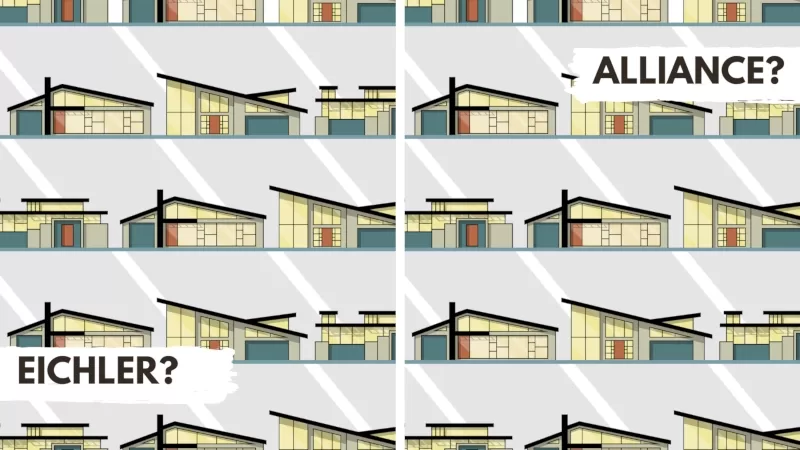If you live in the San Francisco Bay Area, you may be familiar with Eichler homes and their close cousins, Alliance homes. Of the 10,600 homes Eichler designed, approximately 10,000 are in the Bay Area. Marin County warmly embraced the architect’s designs, buying and maintaining more than 1,700 homes in San Rafael, Mill Valley, and San Anselmo.
Architect Joseph Eichler left an indelible stamp on home design. He was ahead of his time with his mid-century modern vision for living. He incorporated what has come to be known as biophilic design, the indoor–outdoor feel of light-filled homes, with floor-to-ceiling windows. Nature was never far away. He also incorporated post-and-beam construction and open floor plans.
Making Housing Affordable
Eichler believed in affordable housing and designed for it. These were homes created for workers and their families: functional, low cost to build, and affordable to purchase. He’d be surprised to find that his homes are now sought after and pricey, located in high-end neighborhoods in San Francisco, Palo Alto, San Mateo and San Jose, and Marin County.
Alliance-built homes from the mid-1950s were a competitor. They also feature indoor–outdoor living and floor-to-ceiling windows. The differences are subtle: among the most notable are higher and sloped ceilings in the Alliances, and courtyards in the Eichlers. Alliances also tend to be a little smaller than Eichlers, making them a more affordable option for buyers looking to own a classic mid-century modern. Hundreds of Alliance homes can be found in Marin, mainly in San Rafael.
Remodeling Eichlers and Alliances
Remodeling presents both opportunity and responsibility for homeowners fortunate enough to live in one of these mid-century modern gems. Whether you’re in an iconic Eichler or a lesser-known but equally significant Alliance home (sometimes called a “likler”), understanding your home’s architectural lineage is key to making upgrades that enhance, not erase, its character.
Below is a breakdown that can help homeowners and design professionals align remodel goals with the essence of each style:
Layout and Spatial Organization
Eichler Homes:
- Designed to blur the boundaries between indoors and outdoors.
- Some feature a central atrium, creating a private outdoor oasis.
- Open-plan interiors with minimal partitions, often a direct line of sight from front to rear.
- Remodel tip: Preserve open sightlines; avoid over-articulating rooms with walls or overly bulky furniture.
Alliance Homes:
- Built with a more conventional, double-loaded bedroom corridor.
- Higher ceilings throughout the home.
Remodel tip: Consider selective wall removal to evoke more openness while still honoring the home’s original layout.
Materials and Construction Details
Eichler:
- Open post-and-beam construction with exposed wood ceilings (often redwood tongue-and-groove).
- Slab foundations with radiant heating, now often needing updates or alternatives.
- Signature vertical grooved plywood exterior finish.
Remodel tip: Retain or restore exposed wood (typically mahogany veneer) where possible. Avoid covering ceilings with drywall, as it erases a defining feature.
Alliance:
- Open post-and-beam construction with exposed wood ceilings with drywall interiors.
- Slab foundations with radiant heating, now often needing updates or alternatives.
Remodel tip: While ceiling materials may not be as expressive, homeowners can add character through period-appropriate finishes (e.g., cork flooring, or Eichler-style exterior siding for authenticity).
Aesthetic and Architectural Identity
Eichler:
- Boldly modernist. Flat or low-pitched roofs, deep overhangs, and unbroken lines of floor-to-ceiling glass.
- Highly intentional design: every component part of a whole.
Remodel tip: Avoid adding traditional ornamentation (e.g., crown molding, colonial doors). Stay true to simplicity, linearity, and natural materials.
Alliance:
- More of a hybrid, borrowing from modernist principles, but often softened for broad market appeal.
- Rooflines are pitched and exteriors may resemble ranch homes, but modernist touches (like horizontal emphasis and modest detailing) are present.
Remodel tip: Consider a modernist “facelift” (e.g., replacing standard windows with larger panes or sliders, hiding utilities where they attach to the home).
Key Design Considerations for Remodeling
Element | Preserve | Upgrade with Sensitivity |
|---|---|---|
| Windows | Original placement & proportions | Use energy-efficient glazing in similar configurations |
| Siding | Vertical grooved plywood, clear cedar | Replace in kind, avoid vinyl or faux materials |
| Floors | Slab and radiant (if functioning) | Update heating system invisibly or supplement with heat pumps |
| Ceilings | Exposed beam or tongue-and-groove wood | Refinish, don’t drywall over |
| Lighting | Minimal, integrated sources | Use recessed or hidden fixtures to maintain clean lines |
| Color Palette | Earthy, nature-inspired tones | Mid-century neutrals with bold accents (avocado, ochre, teal, walnut) |


